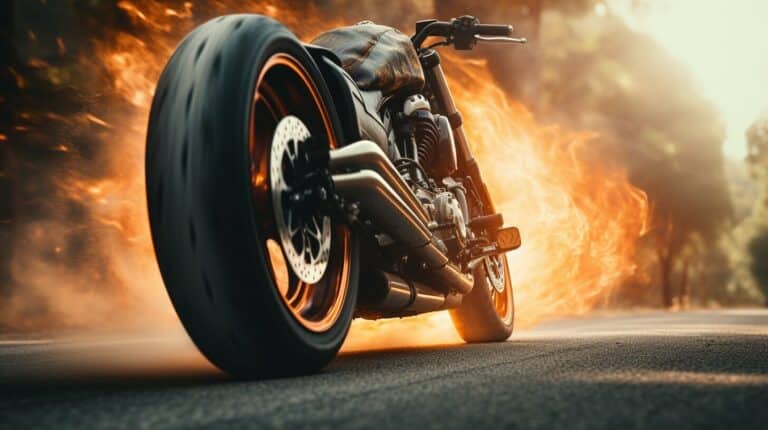Motorcycle burnouts can bring a rush of adrenaline and excitement to any rider’s experience. If you’ve ever wondered how to perform a burnout on a motorcycle, you’ve come to the right place. In this article, we will guide you through the steps to master this thrilling maneuver safely and responsibly.
- Stand with both feet flat on the ground to prevent tire traction.
- Warm up your motorcycle for at least 5 minutes in neutral gear.
- Engage the clutch lever and hold the front brake to prepare for the burnout.
- Rev up the engine close to the red line on the gauge in first gear.
- Lean forward slightly to shift the weight off the rear tire and release the clutch.
- Always perform burnouts in a controlled environment and wear protective gear.
- Be mindful of the laws and safety measures associated with burnouts.
Understanding the Basics of Motorcycle Burnouts
Before diving into the details of executing a perfect burnout, it’s essential to understand the basic components that play a crucial role in the process. The rear tire and front brake are two key elements that require careful control and coordination.
When performing a burnout, start by standing with both feet as flat on the ground as possible to prevent the tires from gaining traction. This is important for maintaining control throughout the maneuver. Next, ensure the motorcycle is properly warmed up by letting it idle for at least 5 minutes in neutral gear.
To initiate the burnout, pull the clutch lever all the way in and hold the front brake with the middle finger of your right hand. Shift the motorcycle into first gear and rev up the engine close to the red line on the gauge. At this point, lean forward slightly to shift the weight off the rear tire. Once everything is set, release the clutch to start the burnout.
It’s important to note that burnouts should be performed in a controlled environment and with the proper safety gear. Additionally, be aware that repeated burnouts can degrade the rear tire over time. Always exercise caution and follow the laws and safety measures associated with burnouts to ensure a fun and safe experience.
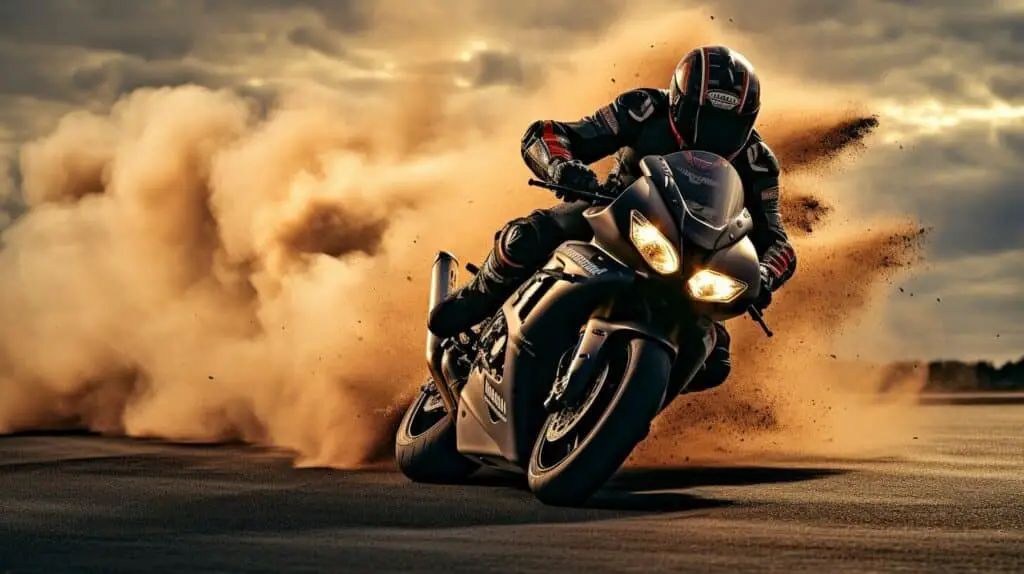
| Rear Tire | Front Brake |
|---|---|
| The rear tire is the one that provides power and traction during a burnout. It is essential to control the rear tire’s grip and prevent it from gaining traction too quickly. | The front brake is used to hold the motorcycle in place during a burnout. By modulating the pressure on the front brake, you can control the balance and stability of the bike. |
Key Steps for a Motorcycle Burnout
- Stand with both feet flat on the ground to prevent traction.
- Warm up the motorcycle for at least 5 minutes in neutral gear.
- Pull the clutch lever all the way in and hold the front brake with the middle finger of your right hand.
- Shift the motorcycle into first gear and rev up the engine close to the red line.
- Lean forward slightly to shift the weight off the rear tire.
- Release the clutch to initiate the burnout.
- Reengage the clutch and release the throttle to end the burnout.
- Ensure the rear tire has completely stopped spinning before releasing the front brake.
Perform burnouts responsibly, respecting the laws and safety measures associated with this thrilling motorcycle maneuver.
Preparing Your Motorcycle for a Burnout
Before you kick up the smoke, there are a few important preparations you need to make to ensure a safe and thrilling burnout experience on your motorcycle. These steps will help you set the stage for a successful burnout while minimizing the risk of accidents or damage to your bike.
1. Check your clutch lever: Make sure your clutch lever is in good working condition and adjusted properly. A well-functioning clutch is essential for controlling the power delivery to your rear wheel during a burnout. If you notice any issues with the clutch lever, have it inspected and repaired by a professional before attempting a burnout.
2. Inspect your gear shift pedal: Ensure that your gear shift pedal is functioning smoothly and allows for easy gear changes. A properly working gear shift pedal ensures that you can shift gears quickly and accurately during the burnout, enhancing your control over the motorcycle.
3. Check your front wheel: It’s crucial to inspect your front wheel and ensure that it is properly aligned and inflated. A wobbling or underinflated front wheel can affect the stability of your motorcycle during the burnout, making it harder to maintain control. Take the time to check the tire pressure and make any necessary adjustments before attempting a burnout.
4. Gear up with protective gear: Before engaging in any burnout, always prioritize your safety by wearing the appropriate protective gear. This includes a helmet, gloves, sturdy boots, and protective clothing. In the event of a fall or accident, wearing proper gear can significantly reduce the risk of injuries. Remember, safety should always be your top priority.
| Key Preparations for a Motorcycle Burnout | Benefits |
|---|---|
| Check clutch lever | Ensures proper control of power delivery |
| Inspect gear shift pedal | Facilitates smooth and quick gear changes |
| Check front wheel | Enhances stability and control during burnout |
| Gear up with protective gear | Minimizes the risk of injuries |
By following these preparations, you’ll be well on your way to performing a thrilling motorcycle burnout while also prioritizing your safety and the longevity of your bike. Remember to always respect the laws and regulations regarding burnouts, perform them in designated areas, and be considerate of others around you. Now that your motorcycle is ready, let’s dive into the step-by-step guide on mastering the technique of a perfect burnout.
Mastering the Technique: Step-by-Step Guide
Now it’s time to delve into the nitty-gritty details of executing a successful motorcycle burnout, beginning with throttle control and proper gear selection. These two factors play a crucial role in achieving a controlled and impressive burnout.
To start, make sure your motorcycle is in first gear and the engine is properly warmed up. Standing with both feet flat on the ground, pull the clutch lever all the way in and hold the front brake with the middle finger of your right hand. This ensures that the motorcycle stays stationary while you rev up the engine.
Once you’re ready, gradually increase the engine throttle to reach close to the red line on the gauge. This will generate enough power to initiate the burnout. Remember to lean forward slightly to shift the weight off the rear tire, aiding in traction loss. Now release the clutch to engage the power to the rear wheel, and you’ll witness the tire spinning and smoke billowing.
| Throttle Control Tips | Gear Selection Tips |
|---|---|
|
|
When you’re ready to end the burnout, reengage the clutch by pulling the lever back in, release the throttle, and ensure that the tire has completely stopped spinning before releasing the front brake. This step is crucial to avoid sudden movements or loss of control.
Remember, performing burnouts should only be done in a controlled environment and always wear proper protective gear, including a helmet, gloves, and sturdy footwear. It’s also important to be aware that burnouts can degrade the rear tire over time, so take caution and keep an eye on tire wear to ensure your safety on the road.
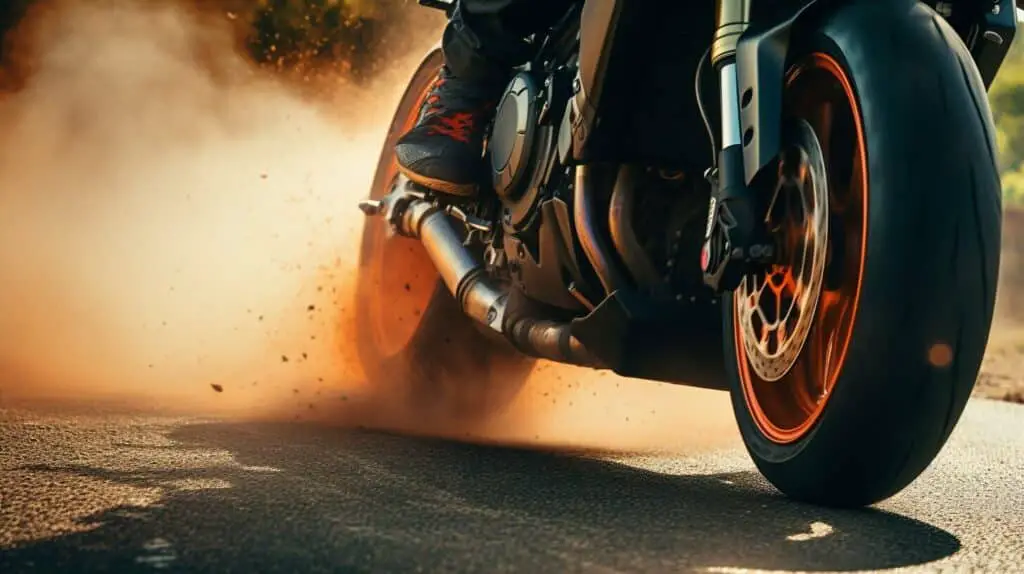
Performing a burnout requires skill and practice, but once mastered, it can be an exhilarating way to showcase your motorcycle’s power and control. Just remember to always prioritize safety and be mindful of the laws and safety measures associated with burnouts.
Tips for a Perfect Burnout
Want to take your burnout skills to the next level? These pro tips will help you achieve the perfect balance, control, and style in your motorcycle burnouts. Follow these steps to ensure a flawless performance that will leave spectators in awe.
- Control the traction: When performing a burnout, it’s crucial to find the right balance of traction. Too much traction can hinder the rear tire from spinning, while too little can cause the tire to lose control. Experiment with different throttle control techniques to find the sweet spot where the rear wheel maintains a controlled spin.
- Utilize the neutral gear: Engaging the neutral gear can make it easier to initiate and maintain a burnout. It allows the rear wheel to spin freely while reducing the risk of the motorcycle lurching forward. Before attempting a burnout, shift the gear lever into neutral, ensuring a smoother and more controlled performance.
- Lean forward: To enhance your control during a burnout, lean slightly forward to shift your weight off the rear tire. This will help to prevent the motorcycle from tipping backward and maintain stability throughout the burnout. Remember to maintain a firm grip on the handlebars while leaning forward to maintain full control of the motorcycle.
Remember, safety should always be your top priority when performing motorcycle burnouts. Wear proper protective gear, including a helmet, gloves, and suitable attire. Perform burnouts in a controlled environment, away from traffic, pedestrians, and obstacles. Always be mindful of the laws and safety measures associated with burnouts, and never put yourself or others at risk.
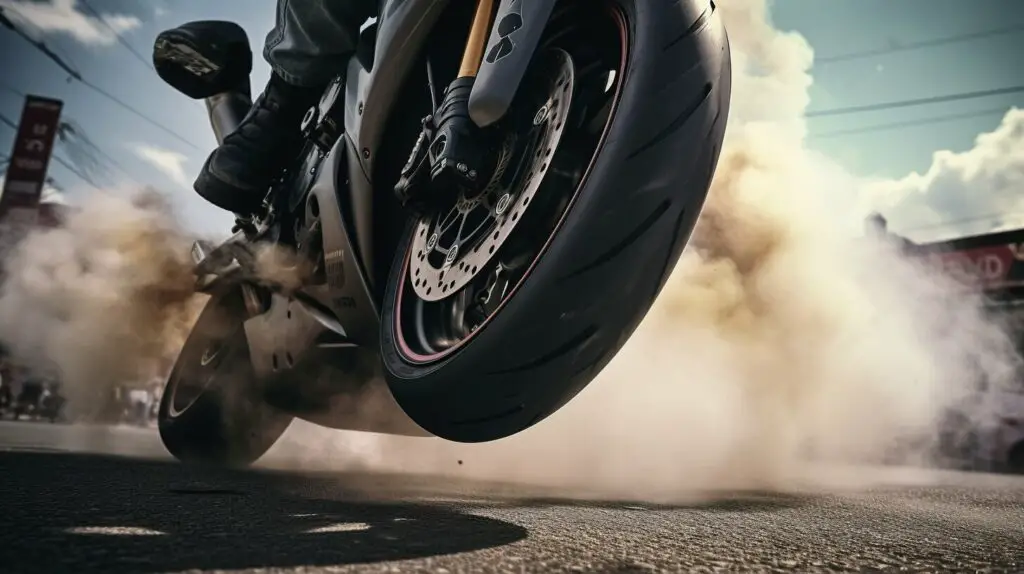
“The key to a perfect burnout is knowing your limits and gradually pushing beyond them. Practice in a safe and controlled environment, gradually increasing your speed and duration. This will help build your skills and confidence while minimizing the risk of accidents or injuries.” – Experienced Rider
By following these tips and practicing regularly, you’ll be able to master the art of motorcycle burnouts. Keep in mind that each motorcycle may have slight variations in technique, so it’s important to familiarize yourself with your specific bike’s characteristics. With patience, practice, and a commitment to safety, you’ll be able to perform impressive and controlled burnouts that will leave a lasting impression.
| Pro Tips for Perfect Burnouts: | |
|---|---|
| Control the traction | Find the right balance to maintain a controlled spin. |
| Utilize the neutral gear | Shift into neutral for smoother initiation and control. |
| Lean forward | Shift your weight to maintain stability and prevent tipping backward. |
Safety Measures and Risks Involved
While motorcycle burnouts can be exhilarating, it’s crucial to prioritize safety to ensure both your well-being and the well-being of others. Performing burnouts can pose risks if not executed with caution and proper technique. By following these safety measures, you can enjoy the thrill of a burnout while minimizing potential dangers.
1. Find the Right Location
When attempting a burnout, choose a controlled environment with ample space. Look for an empty parking lot or a closed-off area where there are no pedestrians or vehicles nearby. It’s important to have enough room to maneuver your motorcycle safely without the risk of colliding with any obstacles.
2. Wear Protective Gear
Always wear appropriate safety gear, including a helmet, gloves, long sleeves, and sturdy boots. In the event of a mishap, these protective items can significantly reduce the risk of injuries. Remember, safety should never be compromised for the sake of a burnout.
3. Know Your Limits
Before attempting a burnout, make sure you have sufficient riding experience and are well-versed in motorcycle control. It’s crucial to understand the capabilities of your bike and the limits of your skills. Pushing beyond your limits can lead to accidents and injuries.
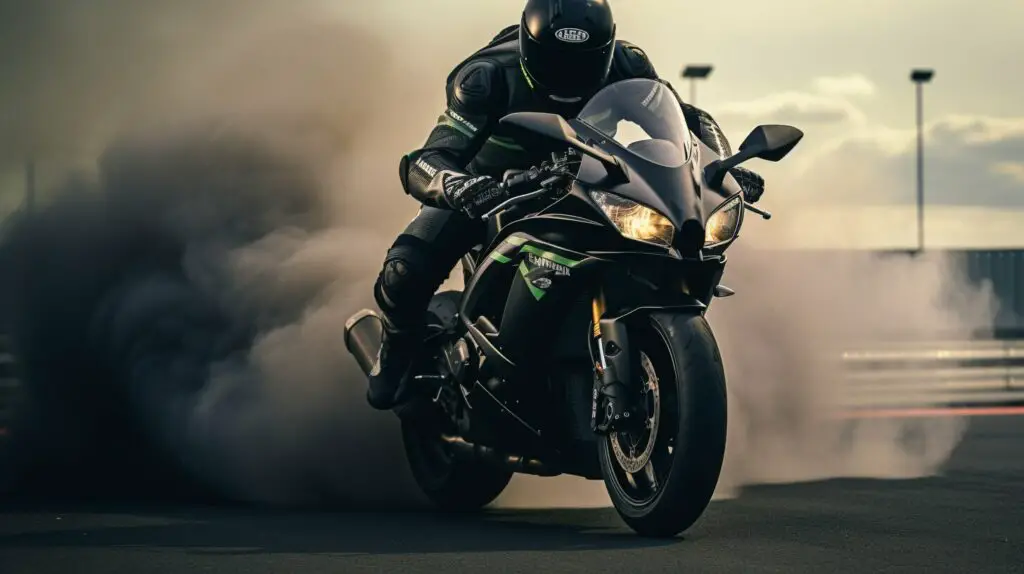
When performing a burnout, ensure that you’re in the right gear. First gear is typically the optimal choice, as it provides enough power to spin the rear tire without excessive speed. Additionally, pay attention to gaining traction on the rear tire, as too much traction can hinder the burnout. Find the right balance to achieve the desired effect.
By adhering to these safety measures, you can minimize the risks associated with motorcycle burnouts. Remember, safety should always be your top priority. Enjoy the adrenaline rush responsibly and make every ride a thrilling yet secure experience.
Effects of Motorcycle Burnouts
It’s time to dive into the aftermath of a motorcycle burnout, from the impact on your bike’s temperature gauge to the billowing clouds of smoke – and debunk a few myths along the way. When performing a perfect burnout, it’s natural to expect some consequences.
Temperature Gauge
One of the immediate effects of a burnout is an increase in the bike’s temperature gauge. The intense spinning of the rear tire generates friction, causing the engine to work harder and heat up. While most motorcycles are designed to handle such conditions, it’s important to keep an eye on the temperature gauge and avoid prolonged burnouts that could lead to overheating.
Clouds of Smoke
A big cloud of smoke is synonymous with a successful burnout, as the tire’s rapid rotation creates intense heat, resulting in the smoking effect. The size and density of the cloud depend on factors such as tire composition, tire pressure, and the duration of the burnout. It’s important to note that excessive smoke can obscure visibility, so always perform burnouts in a controlled environment away from traffic and pedestrians.
Myth Busting: The Middle Finger
“Contrary to popular belief, giving the middle finger during a burnout does not increase its performance or make it more impressive.”
The myth of the middle finger gesture during a burnout has persisted, with claims that it adds an extra element of flair. However, this gesture has no effect on the actual burnout itself. It’s simply a personal expression and does not impact the physics or mechanics of the burnout. So, feel free to skip the middle finger and focus on perfecting the technique instead.
In summary, performing a motorcycle burnout can result in increased engine temperature, billowing clouds of smoke, and the occasional myth to be debunked. While these effects can add excitement and visual appeal to a burnout, it’s important to exercise caution and be mindful of safety measures. Now that we’ve explored the aftermath of a burnout, let’s move on to legal and social considerations associated with this thrilling motorcycle maneuver.
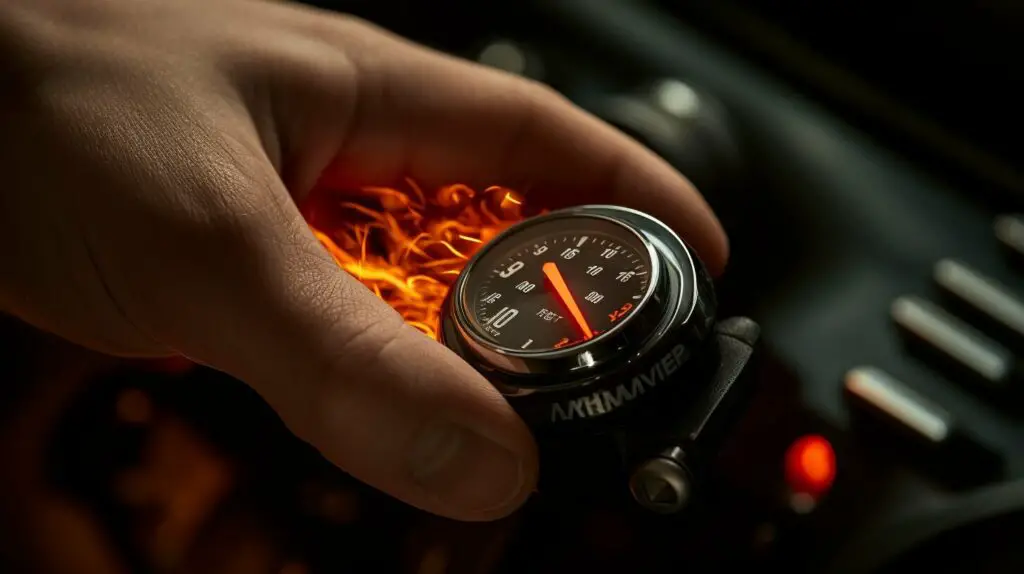
| Effect | Description |
|---|---|
| Increased Engine Temperature | The intense spinning of the rear tire generates friction, causing the engine to work harder and heat up. |
| Billowing Smoke | The rapid rotation of the tire creates intense heat, resulting in a big cloud of smoke. |
| Myth Busting: The Middle Finger | Contrary to popular belief, giving the middle finger during a burnout does not affect its performance. |
While the thrill of a motorcycle burnout can be tempting, it’s important to be aware of the legal and social considerations that come with it. Performing a burnout can pose risks not only to yourself but also to other riders and the general public. Understanding and following the laws and safety measures associated with burnouts is crucial to ensure a safe and enjoyable experience.
When it comes to legal considerations, it’s essential to know that performing a burnout in public areas or on public roads is generally illegal. Many jurisdictions consider it a form of reckless driving, which can result in significant fines, license suspension, or even criminal charges. It’s important to check local traffic laws and regulations to understand the specific rules in your area.
Aside from the legal implications, burnouts can also have social consequences. While some riders find burnouts impressive, others may view them as disruptive or dangerous behavior. It’s important to consider the impact of your actions on other riders, pedestrians, and the community as a whole. Respect for others and responsible riding should always be a priority.
| Risks Involved: | Absolutely nothing |
|---|---|
| Other riders: | Always consider their safety |
Minimizing Risks and Ensuring Safety
While the risks associated with motorcycle burnouts can be minimized, it’s essential to take appropriate safety measures to protect yourself and others. Here are some tips to help you enjoy burnouts responsibly:
- Perform burnouts in a controlled environment, such as a closed-off track or private property, where you won’t endanger other road users.
- Always wear proper protective gear, including a helmet, gloves, boots, and durable clothing to reduce the risk of injury in case of an accident.
- Make sure your motorcycle is in good condition, with properly inflated tires, functioning brakes, and a properly maintained engine.
Remember, the goal is to have fun while maintaining safety and respect for others. By following the legal and social considerations, you can enjoy the exhilaration of a motorcycle burnout without risking harm to yourself or others.
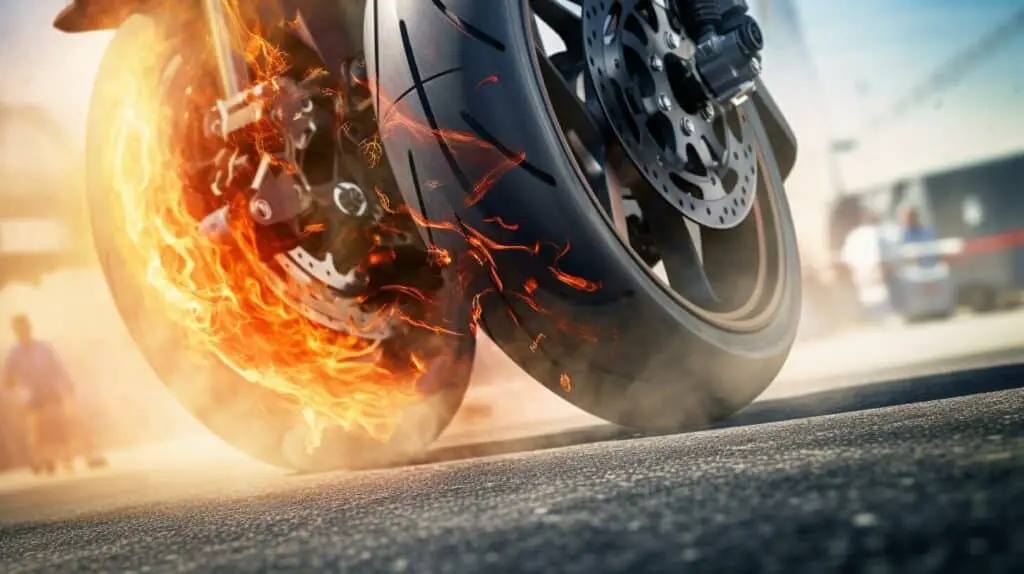
| Legal and Social Considerations Summary | |
|---|---|
| Legal Considerations: | Performing a burnout in public areas is generally illegal and can lead to fines, license suspension, or criminal charges. |
| Social Considerations: | Be mindful of the impact of burnouts on other riders and the community, demonstrating respect and responsible riding. |
Caring for Your Motorcycle After a Burnout
Once you’re done tearing up the pavement with your burnout skills, it’s time to give your trusty steed some well-deserved post-burnout care and attention. After all, you want to ensure that your bike stays in top condition for future rides and burnout sessions. Here are some essential steps to take in caring for your motorcycle after a burnout:
- Inspect the brake system: Start by checking the condition of your brakes, as they can undergo significant stress during a burnout. Look for any signs of wear or damage, and ensure that the brake pads are in good condition. If necessary, replace any worn-out components to maintain optimal braking performance.
- Turn your attention to the tires: Your rear tire, in particular, bears the brunt of the burnout. Examine the tire for signs of excessive wear, such as uneven tread or bald spots. A well-worn tire may not provide the same level of traction and control, so consider replacing it if necessary. Additionally, check the tire pressure and adjust it to the manufacturer’s recommendations.
- Pay attention to the controls: The left hand controls the clutch, while the right handlebar houses the front brake lever. Take a moment to ensure that both the clutch lever and front brake lever are in proper working order. Look for any signs of damage or excessive play and make the necessary adjustments or repairs.
- Give your bike a thorough clean: After a burnout session, your motorcycle may be covered in dirt, debris, or rubber residue. Take the time to clean your bike, paying extra attention to the areas affected by the burnout. Use a gentle detergent and a soft cloth or sponge to remove any grime, and finish off with a protective wax or polish to keep your bike shining.
Remember, a burnout can put your bike through its paces, so it’s essential to give it the care it deserves afterwards. By following these steps and ensuring your motorcycle is in good shape, you’ll be ready for your next thrilling burnout adventure. Keep in mind the importance of safety and being mindful of the laws and regulations surrounding burnouts. Now, get out there and enjoy the ride!
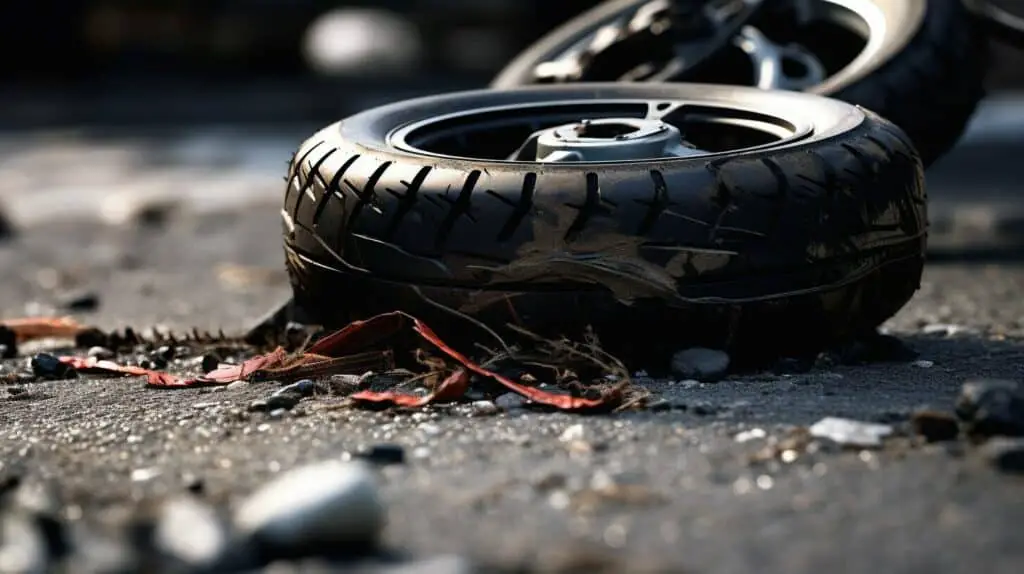
| Steps to Care for Your Motorcycle After a Burnout: |
|---|
| 1. Inspect the brake system |
| 2. Check the condition of the tires |
| 3. Ensure the clutch lever and front brake lever are in good working order |
| 4. Clean your bike thoroughly |
Conclusion
Motorcycle burnouts offer an exhilarating experience for riders seeking an adrenaline rush, but it’s crucial to balance the excitement with proper safety measures and respect for the motorcycle and those around you. To perform a burnout on a motorcycle, follow these steps:
- Stand with both feet flat on the ground to prevent tires from gaining traction.
- Start the motorcycle and let it warm up for at least 5 minutes in neutral gear.
- Pull the clutch lever all the way in and hold the front brake with the middle finger of your right hand.
- Put the motorcycle into first gear and rev up the engine close to the red line on the gauge.
- Lean forward slightly to shift the weight off the rear tire, then let go of the clutch to start the burnout.
- To end the burnout, reengage the clutch and release the throttle. Make sure the tire has completely stopped spinning before releasing the front brake.
It’s essential to perform burnouts in a controlled environment and always wear protective gear. Remember, burnouts can degrade the rear tire over time, so take caution and be mindful of the laws and safety measures associated with burnouts.
By following these guidelines, you can enjoy the thrill of performing a motorcycle burnout while ensuring your safety and the longevity of your bike. So, have fun, be responsible, and ride safely!
FAQ
Q: How do I perform a burnout on a motorcycle?
A: To perform a burnout on a motorcycle, follow these steps: 1) Stand with both feet flat on the ground to prevent traction. 2) Warm up the motorcycle in neutral gear. 3) Pull the clutch lever and hold the front brake. 4) Shift into first gear and rev the engine close to the red line. 5) Lean forward slightly to shift weight off the rear tire. 6) Release the clutch to start the burnout. 7) To end the burnout, reengage the clutch and release the throttle. Ensure the tire has completely stopped spinning before releasing the front brake.
Q: Where should I perform burnouts?
A: It’s important to perform burnouts in a controlled environment, such as an empty parking lot or a closed course. Avoid doing burnouts on public roads or in areas with pedestrian traffic.
Q: Do I need to wear protective gear while doing a burnout?
A: Yes, always wear proper protective gear when performing a burnout. This includes a helmet, gloves, long pants, and sturdy footwear. Protective gear will help protect you in case of any accidents or injuries.
Q: Can burnouts damage the rear tire?
A: Yes, burnouts can degrade the rear tire over time. The excessive heat and friction generated during a burnout can cause the tire to wear out faster. Regularly inspect your tire for any signs of wear or damage, and replace it if needed.
Q: Are there any legal implications of doing burnouts?
A: Yes, performing burnouts in public areas or on public roads may be illegal and can result in fines or other penalties. It’s important to be aware of the laws and regulations in your area regarding burnouts, and only perform them in designated areas or events where they are permitted.
Q: Are motorcycle burnouts only for experienced riders?
A: Burnouts require a certain level of skill and control, so it’s recommended that only experienced riders attempt them. If you’re a beginner, it’s best to focus on mastering basic riding techniques before attempting burnouts.
Q: Can I do a burnout on an automatic motorcycle?
A: Burnouts are typically performed on motorcycles with manual transmissions. While it may be technically possible to do a burnout on an automatic motorcycle, the lack of a clutch may make it more challenging to control the rear tire and maintain balance.
Q: How long should I warm up the motorcycle before attempting a burnout?
A: It’s recommended to warm up the motorcycle for at least 5 minutes in neutral gear before attempting a burnout. This allows the engine to reach its optimal operating temperature and ensures smooth performance during the burnout.
Q: Can I do a burnout if my motorcycle has a cold engine?
A: It’s best to avoid doing burnouts with a cold engine. The increased friction and stress on the engine components can cause damage. Make sure to let the engine warm up sufficiently before attempting a burnout.

